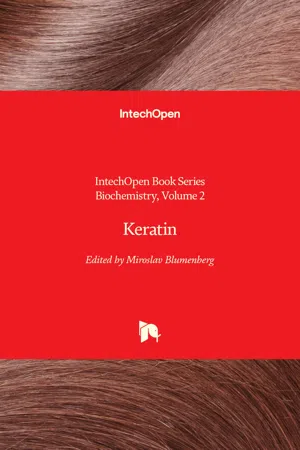Keratin
About this book
Keratin is the proteinaceous body covering layer produced by mammals, birds, fish, reptiles, and amphibians. Hair and wool, horns, claws, hooves, feathers, and scales are made of keratin. Keratin is insoluble in water and is resistant to proteolysis. Importantly, keratin is also the intracellular structural protein that protects living epithelial cells from mechanical damage or stress. The fundamental keratin functions are revealed in congenital human skin diseases caused by mutations in keratin genes, e.g., Epidermolysis bullosa simplex or Epidermolytic hyperkeratosis. Most keratin gene mutations have a dominant-negative effect disrupting the filamentous structure formation even from the natural allele, and leaving the cell with a deficient cytoskeleton. However, industrial scale meat production results in vast quantities of keratin byproduct. Processing this byproduct is, on the one hand a major challenge, and on the other hand, a potential for useful recycling and exploitation.
Frequently asked questions
- Essential is ideal for learners and professionals who enjoy exploring a wide range of subjects. Access the Essential Library with 800,000+ trusted titles and best-sellers across business, personal growth, and the humanities. Includes unlimited reading time and Standard Read Aloud voice.
- Complete: Perfect for advanced learners and researchers needing full, unrestricted access. Unlock 1.4M+ books across hundreds of subjects, including academic and specialized titles. The Complete Plan also includes advanced features like Premium Read Aloud and Research Assistant.
Please note we cannot support devices running on iOS 13 and Android 7 or earlier. Learn more about using the app.
Information
Table of contents
- Keratin
- Contents
- Preface
- Section 1 Introduction
- Section 2 Human Skin Keratins
- Section 3 Physical and Chemical Characteristics
- Section 4 Industrial Treatment of Keratin
